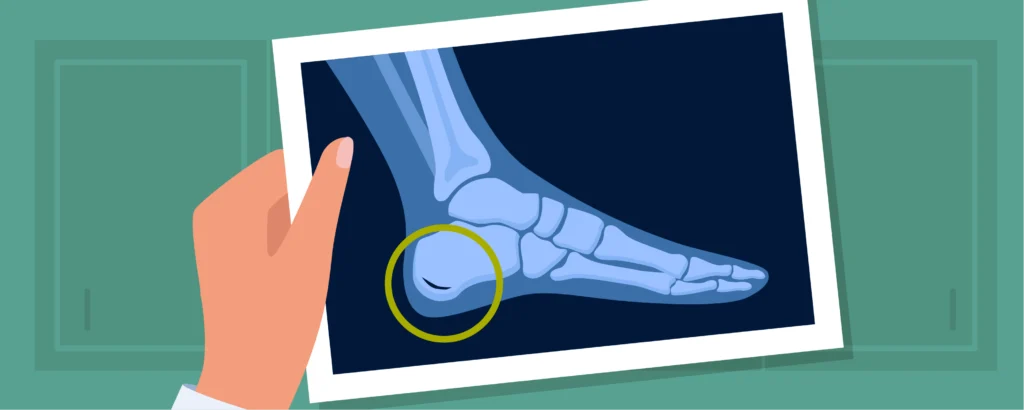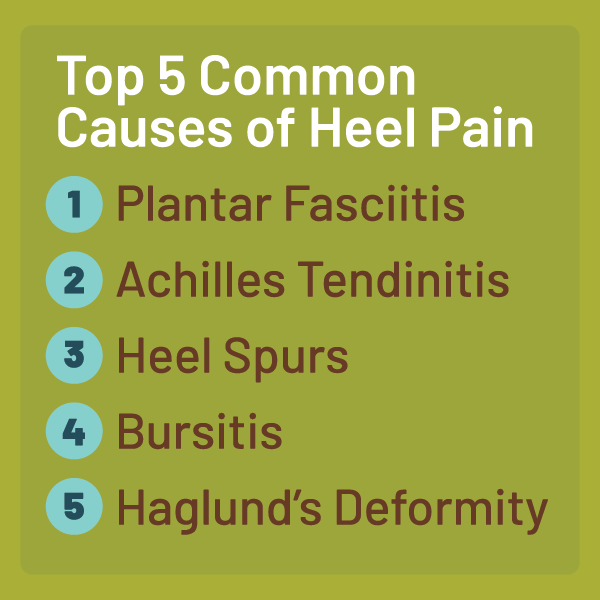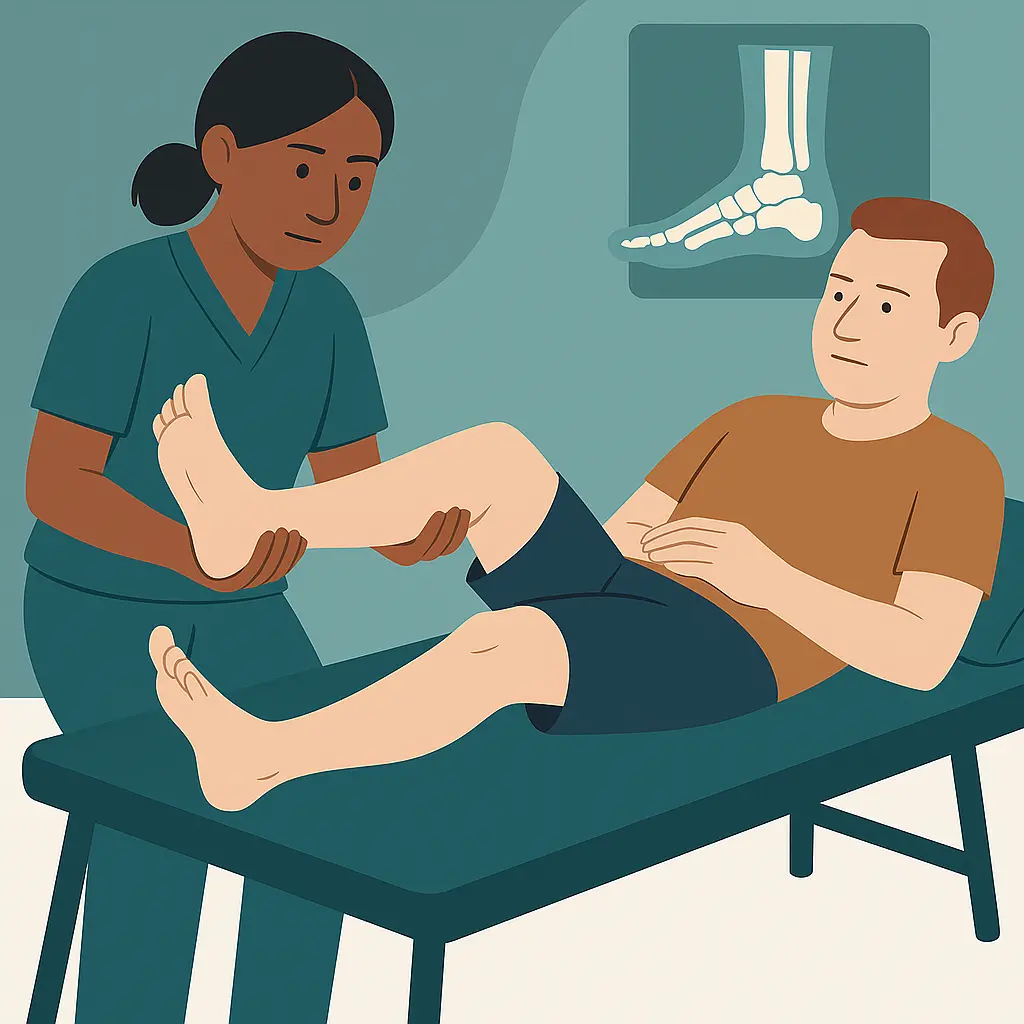Understanding Heel Pain: 5 Common Causes Across All Ages

Heel pain isn’t just a nuisance—it’s one of the most common foot complaints in the United States, affecting people of all ages. But it tends to hit older adults especially hard.
As we age, our bodies naturally lose some of their flexibility and resilience, making the tissues in our feet more prone to wear, tear, and inflammation. That can turn even simple daily activities like walking or standing into a painful ordeal.

Heel Pain by the Numbers
Heel pain doesn’t just affect individuals—it also takes a toll on the healthcare system. Plantar fasciitis, which is the most common cause of heel pain, affects about 1 in 10 people in the U.S.1 at some point in their lives. Each year, it’s responsible for over 600,000 outpatient visits2, and treating it costs an estimated $284 million annually3. Among older adults, roughly 7% report regular heel discomfort4, which can lead to reduced mobility and even increase the risk of falls. Addressing heel pain promptly can prevent chronic issues and restore mobility more effectively while reducing the financial impact on the healthcare system.
Top 5 Common Causes of Heel Pain
1. Plantar Fasciitis
This is the most well-known culprit—and for good reason. Plantar Fasciitis’s caused by inflammation in the thick band of tissue (the plantar fascia) that runs across the bottom of your foot and connects your heel bone to your toes. It usually feels like a stabbing pain when you take your first steps in the morning or after sitting for a long time.
2. Achilles Tendinitis
This happens when the Achilles tendon—the one that connects your calf muscles to your heel—gets overused or irritated. Achilles Tendinitis often affects runners, people who suddenly ramp up their physical activity, or those who don’t stretch enough before moving. Pain shows up just above the heel and tends to get worse with movement.
3. Heel Spurs
Heel spurs are calcium deposits that build up over time on the bottom of your heel. On their own, they’re not always painful. But when they accompany conditions like plantar fasciitis, they can make walking or standing feel like stepping on a tack. Contrary to popular belief, the spur itself is not the source of pain. It is the inflammation within the fascia that creates the pain in the bottom of the foot. In addition, spurs in the back of the heel can be a source of irritation, especially in the achilles tendon.
4. Bursitis
There’s a little fluid-filled sac called a bursa at the back of your heel that helps reduce friction. But if it gets inflamed—thanks to things like overuse or tight shoes—you can develop bursitis, which causes swelling, redness, and tenderness in the bottom of the heel or at the back of the foot.
5. Haglund’s Deformity
Also nicknamed the “pump bump,” this is a bony enlargement at the back of the heel. Haglund’s Deformity usually shows up in people who frequently wear stiff-backed shoes, like high heels or dress shoes. The friction irritates the soft tissues, and pain quickly follows.
Understanding the Lesser-Known Causes of Heel Pain
Heel pain is one of the most common complaints people bring to their podiatrist—and while conditions like plantar fasciitis and heel spurs get most of the spotlight, there are several lesser-known but equally troublesome causes of heel discomfort that deserve attention.
Understanding these conditions can help you know when it’s time to see a podiatrist and what to expect during diagnosis and treatment.
1. Tarsal Tunnel Syndrome: Nerve Trouble in the Foot
Tarsal tunnel syndrome is often described as the foot’s version of carpal tunnel syndrome. It occurs when the posterior tibial nerve, which runs along the inside of your ankle and into your foot, becomes compressed.
The result? You might feel burning, tingling, or shooting pain in your heel or arch. Some people describe it as an electric shock sensation that gets worse with activity or at night.
This condition is commonly caused by flat feet, swelling from an ankle injury, or underlying medical conditions like diabetes or arthritis. A podiatrist can diagnose it with a physical exam and sometimes nerve testing, and treatments might include orthotics, anti-inflammatory strategies, or, in some cases, surgery.
2. Stress Fractures: Tiny Cracks, Big Pain
Stress fractures are small, hairline cracks in the bone that result from repetitive impact—think long walks, running, or even standing for hours in unsupportive shoes.
In the heel, a calcaneal stress fracture can cause deep, aching pain that worsens with weight-bearing activity. Unlike a sudden injury, this type of pain usually creeps in gradually and can stay hidden for a while. Stress fractures typically take at least 2 weeks to show up on a plain x-ray.
People with low bone density, athletes, and individuals who suddenly increase their activity level are most at risk. Early intervention is key, since continuing to walk on a stress fracture can make it worse. If caught early, rest, supportive footwear, or temporary offloading (like a walking boot) can help the bone heal without surgery.
3. Sever’s Disease: A Growing Pain for Kids
If your child or teen is limping or complaining of heel pain—especially after sports—it might be Sever’s disease, also known as calcaneal apophysitis.
Despite the name, it’s not a disease in the traditional sense. It’s an overuse injury caused by inflammation at the growth plate in the heel, typically during puberty when bones grow faster than tendons can keep up.
The pain usually flares during physical activity and improves with rest. Our pediatric podiatrists recommend stretches, rest periods, cushioned shoes, or orthotic inserts to relieve the pressure and keep kids moving comfortably. The good news; they clear up and create no long-lasting problems for your child.
4. Fat Pad Atrophy: When Natural Cushioning Disappears
Our heels are built to absorb shock, thanks to a thick, protective fat pad beneath them. But over time—especially with age or after years of walking on hard surfaces—that cushioning can wear thin.
This condition, known as fat pad atrophy, leaves you feeling like you’re walking on bone. The pain is often sharp and directly under the heel.
Supportive shoes, cushioned inserts, and offloading techniques can make a world of difference. In some cases, your podiatrist may recommend special padding or even regenerative treatments to improve comfort.
How Podiatrists Treat Heel Pain
A licensed podiatrist doesn’t just look at the pain—they look at the whole picture. After a physical exam, review of your medical history, and sometimes imaging tests like an X-ray or ultrasound, they’ll create a personalized plan based on the root cause of your discomfort. Patients benefit from state-of-the-art care for heel pain, including noninvasive approaches like shockwave therapy and traditional treatments designed to promote optimal healing.

Common treatments might include:
- Physical therapy to stretch and strengthen the foot and lower leg.
- Custom orthotics that correct the way your foot moves.
- Anti-inflammatory meds to ease pain and swelling.
- Shockwave therapy or other advanced methods to stimulate healing.
- Surgery, in rare cases when other treatments don’t work.
What You Can Do After the Visit
Once you’ve seen an Upperline Health podiatrist, there’s still plenty you can do at home to stay ahead of heel pain:
- Avoid barefoot, especially first thing in the morning or rising from periods of rest.
- Stick with the plan your podiatrist gives you—those stretches and orthotics really do help.
- Wear supportive shoes with good cushioning and arch support (ditch the flip-flops for now).
- Manage your weight, if needed, to reduce pressure on your feet.
- Stay active but focus on low-impact exercises like swimming or cycling to avoid flare-ups.
- Keep tabs on your symptoms—if anything changes or gets worse, follow up early instead of waiting.
Wrapping It Up
Heel pain is incredibly common, especially as we age, but it doesn’t have to be something you live with. From plantar fasciitis to heel spurs, there are many causes—but also many solutions. The sooner you identify the problem and get help, the sooner you can get back to doing what you love, pain-free. If your heels are hurting, don’t wait it out. Talk to an Upperline Health podiatrist near you who can help you find real relief. Because healthy feet mean better mobility, more freedom, and a much happier you. And remember, a little attention to your feet today can save you from a lot of pain tomorrow.
About the Author

Dr. Michael King is the Chief Medical Officer of Upperline Health in Nashville, TN.
Dr. King maintained a limb salvage practice in Fall River, MA for many years. He attended Kent State University College of Podiatric Medicine where he obtained his Doctor of Podiatric Medicine (DPM) degree in 1983. He completed his Podiatric surgical residency at Toledo Riverside Hospital in Toledo, OH. He is board certified by the American Board of Foot & Ankle Surgeons and is a Fellow of the American College of Foot & Ankle Surgeons. He is a past president of the American Podiatric Medical Association. Dr. King also gives back to his profession by serving as an adjunct clinical faculty as well as Vice-chair of the Kent State University College of Podiatric Medicine.
References
- https://pmc.ncbi.nlm.nih.gov/articles/PMC10210451
- https://pmc.ncbi.nlm.nih.gov/articles/PMC10210451
- https://www.researchgate.net/publication/371040167_Healthcare_usage_and_cost_for_plantar_fasciitis_a_retrospective_observational_analysis_of_the_2010-2018_health_insurance_review_and_assessment_service_national_patient_sample_data
- https://www.researchgate.net/publication/44692192_Economic_burden_of_plantar_fasciitis_treatment_in_the_United_States



